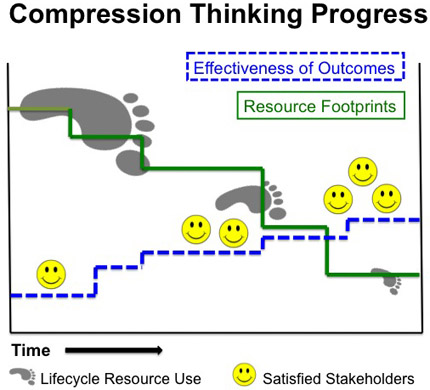 July 28, 2011
July 28, 2011
The diagram depicts a key challenge of Compression Thinking, using a simple framework to factor our huge global challenges into things that a work organization must do to contribute to global impact. In most cases, substantial change will require operating very differently. The risks of changing a successful business model usually terrify the managers of an established business. No one wants to go bankrupt.
Compression Thinking attempts to reconcile two opposing ideas. First, greatly reduce the footprints of the resources we use. Second, maintain or improve the effectiveness of outcomes (or quality of life) from using these resources. To do that, work organizations must rethink what they fundamentally are and should do. No two organizations face exactly the same situation. No magic techniques will make these conflicts disappear. All Compression Thinking can do is guide leaders to view their problems very differently.
A couple of brief examples may illustrate how this might go.
1. PortionPac Chemical is a Chicago-based manufacturer of cleaning chemicals previously described in this newsletter. Its unique feature is Flat Fee, annual contracts to train cleaning personnel to use the right amounts of a few chemicals and produce superior cleaning outcomes. With Flat Fee, the company sells outcomes, not chemicals.
The quantity of chemicals used quickly drops by 20-40%, but the continuing value to customers is the benefits of better cleaning – less emergency maintenance, reduced illness, fewer accidents, less storage space, and so on. Cleaning personnel that think on the job continue to improve the effectiveness of outcomes. Considering operations at both PortionPac and its customers, the green line in the graph above would show a rapid initial decrease in resource footprint, followed by slow decline. The blue dotted line (cleaning effectiveness) would begin a slow ascent, but probably never level off.
2. Because Israel is very dry, Israelis are at the forefront of research and practice on water usage. Emefcy is an Israeli startup with a novel idea for treating wastewater in sewage plants, and which could reduce the use of energy and water everywhere in the industrial world. Globally, wastewater treatment consumes about 80,000 megawatts per year, or roughly 2% of global electrical generating capacity. (MIT) Emefcy intends to enable each sewage plant to self-generate the power necessary for its own purification processes.
Emefcy’s technology is based on banks of microbial fuel cells in which ion membranes separate anaerobic anode chambers from cathode chambers. Organic fuel cells are far from new, but an industrial-sized MEGGAWATTER™ in the variable environment of a municipal sized sewage treatment plant is a huge scale-up of the concept. It’s going well enough that a joint venture of GE-NRG-ConocoPhillips has invested in Emefcy.
How would this plot on the Compression Thinking progress graph above? The resource footprint of a sewage plant (green line) would show a big drop; with learning, the resource footprint for Emefcy’s own operations might drop too. Effectiveness (blue dotted line) for a sewage plant might not move at all – but who knows? Emefcy’s future business model could be learning with clients how to improve conversion of sewage to drinking water.
